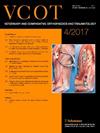Autologous Micro-fragmented Adipose Tissue Augmented by Platelet-Rich Plasma in Nonresponsive Distal Interphalangeal Joint Osteoarthritis in Horses: A Case Series of Eight Horses
IF 1
2区 农林科学
Q3 VETERINARY SCIENCES
Veterinary and Comparative Orthopaedics and Traumatology
Pub Date : 2023-09-01
DOI:10.1055/s-0043-1775607
引用次数: 0
Abstract
Case Report: This retrospective case series presents the outcomes after intra-articular injection of autologous micro-fragmented adipose tissue (AMFAT) augmented by platelet-rich plasma (PRP) in horses with history of unsuccessful previous treatments in the coffin joint. The study included sport horses with front feet distal interphalangeal joint osteoarthritis (DIP-OA), radiological and ultrasonographic examination of the foot, standing MRI examination, arthroscopy, and failure of at least two previous treatments. Patients with DIP-OA due to subchondral cyst lesions or fractures were excluded. Eight client-owned adult horses (13 coffin joints) fulfilled the inclusion criteria. Each horse was treated in the past with hyaluronic acid and cortisone, polyacrylamide hydrogel 2,5%, and additionally, either with autologous conditioned plasma or serum. The AMFAT injection occurred at least 4 months after the last treatment. The harvesting of adipose tissue was performed through mechanical liposuction from the tail head region. The lipoaspirate was transferred into a disposable, closed system (Lipogems) for washing through saline solution and disaggregating mechanically by steel marbles. The end-product was obtained through a size reduction filter. Fifty-five milliliters of blood were proceeded for PRP through double centrifugation. Seven horses became sound 6 weeks posttreatment and five patients remained sound 12 months follow-up. However, only four horses returned to their previous performance. No major complications were observed. Main limitations of this report are the absence of a control group with AMFAT solely and the low number of patients. In conclusion, the AMFAT augmented by PRP may be an alternative treatment option in case of advanced DIP-OA.富血小板血浆增强的马远端指间关节骨性关节炎的自体微碎片化脂肪组织:8匹马的病例系列
病例报告:本回顾性病例系列介绍了在有既往治疗失败史的马的棺材关节内注射富含血小板血浆(PRP)的自体微碎片脂肪组织(AMFAT)后的结果。该研究包括患有前脚远端指间关节骨性关节炎(DIP-OA)的运动马,对足进行放射学和超声检查,站立MRI检查,关节镜检查,以及至少两次先前治疗失败。排除软骨下囊肿病变或骨折导致的DIP-OA患者。8匹客户拥有的成年马(13匹棺材关节)符合入选标准。每匹马过去用透明质酸和可的松,聚丙烯酰胺水凝胶2.5%治疗,另外用自体调节血浆或血清治疗。AMFAT注射发生在最后一次治疗后至少4个月。通过机械抽脂从尾头区域获取脂肪组织。将抽脂液转移到一次性封闭系统(Lipogems)中,通过盐水溶液洗涤,并用钢弹进行机械分解。最终产品是通过尺寸缩减过滤器获得的。双离心取55毫升血液进行PRP检测。7匹马治疗后6周恢复健康,5名患者随访12个月仍保持健康。然而,只有四匹马恢复了他们之前的表现。无重大并发症。本报告的主要局限性是缺乏单独使用AMFAT的对照组和患者数量少。总之,PRP增强AMFAT可能是晚期DIP-OA的替代治疗选择。
本文章由计算机程序翻译,如有差异,请以英文原文为准。
求助全文
约1分钟内获得全文
求助全文
来源期刊
CiteScore
2.00
自引率
15.40%
发文量
49
审稿时长
18-36 weeks
期刊介绍:
Veterinary and Comparative Orthopaedics and Traumatology (VCOT) is the most important single source for clinically relevant information in orthopaedics and neurosurgery available anywhere in the world today. It is unique in that it is truly comparative and there is an unrivalled mix of review articles and basic science amid the information that is immediately clinically relevant in veterinary surgery today.

 求助内容:
求助内容: 应助结果提醒方式:
应助结果提醒方式:


